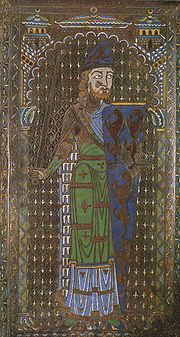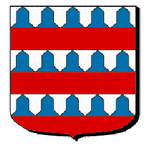
Vair
Encyclopedia

Heraldry
Heraldry is the profession, study, or art of creating, granting, and blazoning arms and ruling on questions of rank or protocol, as exercised by an officer of arms. Heraldry comes from Anglo-Norman herald, from the Germanic compound harja-waldaz, "army commander"...
representation of patches of squirrel
Squirrel
Squirrels belong to a large family of small or medium-sized rodents called the Sciuridae. The family includes tree squirrels, ground squirrels, chipmunks, marmots , flying squirrels, and prairie dogs. Squirrels are indigenous to the Americas, Eurasia, and Africa and have been introduced to Australia...
fur in an alternating pattern of blue and white. As a tincture
Tincture (heraldry)
In heraldry, tinctures are the colours used to emblazon a coat of arms. These can be divided into several categories including light tinctures called metals, dark tinctures called colours, nonstandard colours called stains, furs, and "proper". A charge tinctured proper is coloured as it would be...
, vair is considered a fur and is therefore exempted from the Rule of tincture
Rule of tincture
The first rule of heraldic design is the rule of tincture: metal should not be put on metal, nor colour on colour . This means that Or and argent may not be placed on each other; nor may any of the colours be placed on another colour...
(i.e. it can be placed upon a metal, a colour, or both). Variations of vair are laid out in different patterns, each with their own name. Vair may also be differently coloured, but this is blazon
Blazon
In heraldry and heraldic vexillology, a blazon is a formal description of a coat of arms, flag or similar emblem, from which the reader can reconstruct the appropriate image...
ed as "Vairy of [tincture] and [tincture]", where one tincture must be a metal and the other a colour.
Origins
The word vair, with its variant forms veir and vairé, was brought into Middle EnglishMiddle English
Middle English is the stage in the history of the English language during the High and Late Middle Ages, or roughly during the four centuries between the late 11th and the late 15th century....
from Old French
Old French
Old French was the Romance dialect continuum spoken in territories that span roughly the northern half of modern France and parts of modern Belgium and Switzerland from the 9th century to the 14th century...
, from Latin
Latin
Latin is an Italic language originally spoken in Latium and Ancient Rome. It, along with most European languages, is a descendant of the ancient Proto-Indo-European language. Although it is considered a dead language, a number of scholars and members of the Christian clergy speak it fluently, and...
varius "variegated", and has been alternatively termed variorum opus (Latin, meaning "variegated work"). The Swedish
Swedish language
Swedish is a North Germanic language, spoken by approximately 10 million people, predominantly in Sweden and parts of Finland, especially along its coast and on the Åland islands. It is largely mutually intelligible with Norwegian and Danish...
term gråverk is analogous.
The squirrel in question is a variety of the Eurasian Red Squirrel
Red Squirrel
The red squirrel or Eurasian red squirrel is a species of tree squirrel in the genus Sciurus common throughout Eurasia...
, Sciurus vulgaris. In the coldest parts of Northern and Central Europe, especially the Baltic region
Baltic Sea
The Baltic Sea is a brackish mediterranean sea located in Northern Europe, from 53°N to 66°N latitude and from 20°E to 26°E longitude. It is bounded by the Scandinavian Peninsula, the mainland of Europe, and the Danish islands. It drains into the Kattegat by way of the Øresund, the Great Belt and...
, the winter coat of this squirrel is blue-grey on the back and white on the belly, and was much used for the lining
Lining (sewing)
In sewing and tailoring, a lining is an inner layer of fabric, fur, or other material inserted into clothing, hats, luggage, curtains, handbags and similar items....
of cloak
Cloak
A cloak is a type of loose garment that is worn over indoor clothing and serves the same purpose as an overcoat; it protects the wearer from the cold, rain or wind for example, or it may form part of a fashionable outfit or uniform. Cloaks are as old as human history; there has nearly always been...
s called mantles. It was sewn together in alternating cup-shaped pieces of back and belly fur, resulting in a pattern of grey-blue and grey-white which, when simplified in heraldic drawing and painting, became blue and white in alternating pieces.
Variations

Nebuly
In heraldry and architecture, a line which is drawn nebuly is made up of a series of bulbous protrusions, which are supposed to resemble clouds ....
lines (sometimes blazoned as vair ondé or vair ancien); this is seen in the lining of the cloak depicted on the tomb of Geoffrey V of Anjou (see image).
A vair-like pattern of tinctures other than argent and azure is referred to as vairy (or vairé) of [metal] and [colour]. Other differently tinctured patterns are called counter-vairy, potenty or counter-potenty of [metal] and [colour], though these are rare. A few instances can be found of vairy of four tinctures, but this is very rare.
The height of a row of vair is not strictly specified, but is typically about one-fifth that of the shield. Where there are more than six rows, the term menu-vair may be used. This is the origin of the English word "miniver", which was the general word for the fur lining used for robes of state.
Vair of fewer than four rows is sometimes called beffroi (a French cognate of belfry), probably from the resemblance of a piece of vair to a church tower. The word derives from Old French
Old French
Old French was the Romance dialect continuum spoken in territories that span roughly the northern half of modern France and parts of modern Belgium and Switzerland from the 9th century to the 14th century...
berfroi and Old High German
Old High German
The term Old High German refers to the earliest stage of the German language and it conventionally covers the period from around 500 to 1050. Coherent written texts do not appear until the second half of the 8th century, and some treat the period before 750 as 'prehistoric' and date the start of...
bergfrid, "the one who guards the peace". Originally, a beffroi was a wheeled tower which was used for scaling the walls of a besieged city, similar in shape to the pieces of vair. Later, it was used for a watchtower, and then for any tower where a bell was hung. Vair of two rows, called gros-vair, is also occasionally seen.
Potent
Potent is a fur in heraldryHeraldry
Heraldry is the profession, study, or art of creating, granting, and blazoning arms and ruling on questions of rank or protocol, as exercised by an officer of arms. Heraldry comes from Anglo-Norman herald, from the Germanic compound harja-waldaz, "army commander"...
. It is like vair, except using a T-shaped item instead of the vair bell. (The word "potent" means crutch; it is thought to derive from badly-drawn vair.) It is subject to all the subvarieties of vair, thus counter-potent and so on.
Cinderella's slippers
It is widely believed that PerraultCharles Perrault
Charles Perrault was a French author who laid the foundations for a new literary genre, the fairy tale, with his works derived from pre-existing folk tales. The best known include Le Petit Chaperon rouge , Cendrillon , Le Chat Botté and La Barbe bleue...
's version of the fairytale "Cinderella
Cinderella
"Cinderella; or, The Little Glass Slipper" is a folk tale embodying a myth-element of unjust oppression/triumphant reward. Thousands of variants are known throughout the world. The title character is a young woman living in unfortunate circumstances that are suddenly changed to remarkable fortune...
" was mistranslated into English. The story says that the original French had the slippers made of vair (fur), which was misread as the homophonous
Homophone
A homophone is a word that is pronounced the same as another word but differs in meaning. The words may be spelled the same, such as rose and rose , or differently, such as carat, caret, and carrot, or to, two, and too. Homophones that are spelled the same are also both homographs and homonyms...
verre (glass). This story has been debunked.

